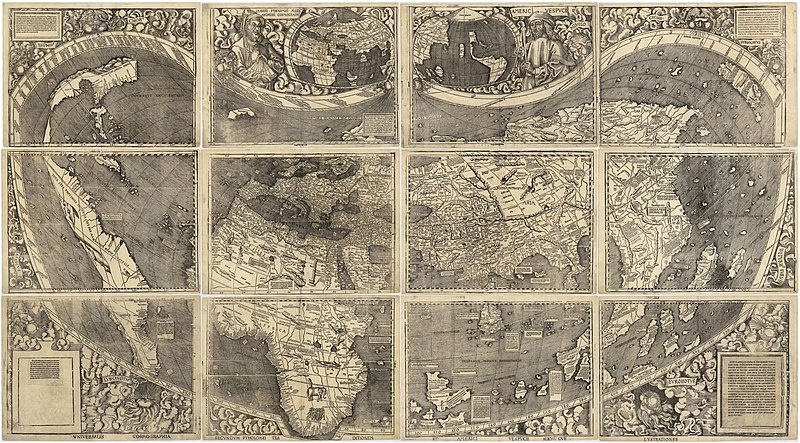My research time in Washington DC has reached its end and I am getting ready to fly back to the UK (between us, I am not ready to face Edinburgh rain yet). Time at the Library of Congress was extremely valuable and allowed me to collect a wide range of material about the Vespucci family.
Library of Congress, Washington DC. Entrance Hall
The documents consulted were only marginally useful to my research as they dealt with the involvement of the Vespucci in political aspects of the Florentine republic. Information about artistic related issues were scattered across the several folders and, unfortunately, none of them provide any answer. I however managed to gather together some potentially interesting clues that will need to be verified once in Florence.
While at the Library of Congress, I took some time to explore the beautiful building and one of the must-see things on my list was the Waldseemuller Map of 1507. The map caught my curiosity while researching on Giorgio Antonio Vespucci (to read about him have a look at the entry posted on July 27th). A well-known humanist in Florence, Giorgio Antonio passed on his knowledge of classical languages to members of his own family, in particular the nephew Amerigo as some Latin exercise books once belonged to the navigator seem to confirm. Uncle and nephew must have also shared common interests in geographical discoveries. Initial research has in fact shown that Giorgio Antonio was not only an important point of reference for the spreading of classical culture but also for the circulation of maps, as he appears to have been involved with Renaissance cartographic production. Studies on Giorgio Antonio’s manuscripts have highlighted the presence of maps and atlases, such as that of Ptolomy, in the humanist library and this, according to some, would confirm Giorgio Antonio’s interest in geographical discoveries and his possible connection with the Waldseemuller Map (on display at the Library of Congress, Jefferson Building).
LoC, Waldseemuller Map, 1507
The Waldseemuller Map is a printed wall map of the world created by the German cartographer Martin Waldseemüller and published in April 1507. The map is based on a modification of Ptolemy's map, expanded to accommodate the Americas. It is the first map to use the name "America" and a drawing of Amerigo Vespucci appears on the top right side. The peculiarity of the map is that it indicates the existence of a new ocean, the Pacific, even if the first records of Europeans sailing this ocean were recorded in 1512-13, a few years after Amerigo’s discoveries. The cartographer Waldseemuller was a member of the the church of Saint-Dié-des-Vosges which was protected by Renee II, Duke of Lorrain. As the Duke studied in Florence under Giorgio Antonio Vespucci, earlier researches have pointed out the connection between Renee II, Waldseemuller and Giorgio Antonio and the possible exchange of geographical knowledge that might have occurred between them and that might have been brought to the creation of a map that anticipated later discoveries. Attention to geographical questions was also paid by Florentine humanists as the circulation of maps, atlases and Geografie seem to have involved several intellectuals among which was Lorenzo di Pierfrancesco de Medici, pupil of Giorgio Antonio.
It also curious to notice that next to the portrait of Amerigo Vespucci on the top of the map, there is a little insect that could be a wasp. As wasps also appear on the family’s coat of arms, this does not generate any surprise. This waspy element however seem to be recurrent in all the pictures today associated with the Vespucci and it starts to appear more and more as a proof-of-identity component. General consensus agrees that, in the past, people had a higher understanding of art works than the one we have today. They possessed tools and knowledge to easily understand the meaning and the symbology of a painting. I therefore wonder what a depiction of wasps would have come across as. Would have the viewer of Botticelli’s Venus and Mars, for instance, associated the presence of wasps to the Vespucci or would have those insects conveyed a different meaning? And were depictions of wasps recurrent in paintings? Umm, something to think about…
(for Botticelli’s Venus and Mars and its connection with the Vespucci family please see previous posts, in particular 22nd December 2010)
Sources (for full reference see the Bibliography page)
• Gallori Nencioni 1997
• Gentile 1992
• Graziosi (Stretto di Benguela, online)
• Perini 1993
• Piani Baratono (Teofanie Cosmologiche, online)
• Verde 1973
• Woodward 2007

